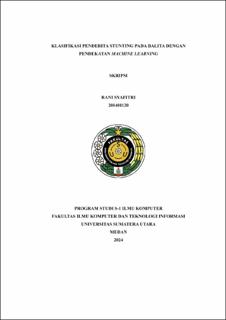Klasifikasi Penderita Stunting pada Balita dengan Pendekatan Machine Learning
Classification of Stunting Patients in Toddlers with a Machine Learning Approach

Date
2024Author
Syafitri, Rani
Advisor(s)
Selvida, Desilia
Nainggolan, Pauzi Ibrahim
Metadata
Show full item recordAbstract
Stunting is still a major nutritional issue in Indonesia. Stunting is a condition in which a child's growth is impaired due to lack of adequate nutritional nutrition. According to the World Health Organization (WHO, 2020), stunting is interpreted as a state in which a child's short or very short body is compared to an age-appropriate height (PB/U) that is <-2 standard deviation (SD) in the WHO growth chart. Ongoing stunting issues can affect children's lives in adolescence and adulthood, such as low productivity, limited cognitive capabilities, overweight, and increased risk of chronic disease. The focus of this study is to make a classification model of stunted children applying random forest algorithm based on anthropometric indicators of body length by age (PB/U) with short (stunted), very short (severely stunted), and normal nutritional status. The information used in this study was obtained from the Medan City Health Office as many as 592 data. This research process involves training random forest model and put it into flask. The findings of this study indicate that the random forest algorithm test using 80% of training data and 20% of testing data resulted in 84% accuracy, 83% precision, 84% recall, and 83% f1-score. The results of the evaluation of the confusion matrix showed that the short label is most easily predicted by the model because the short data in the model more than the very short and normal data.
Collections
- Undergraduate Theses [1253]
